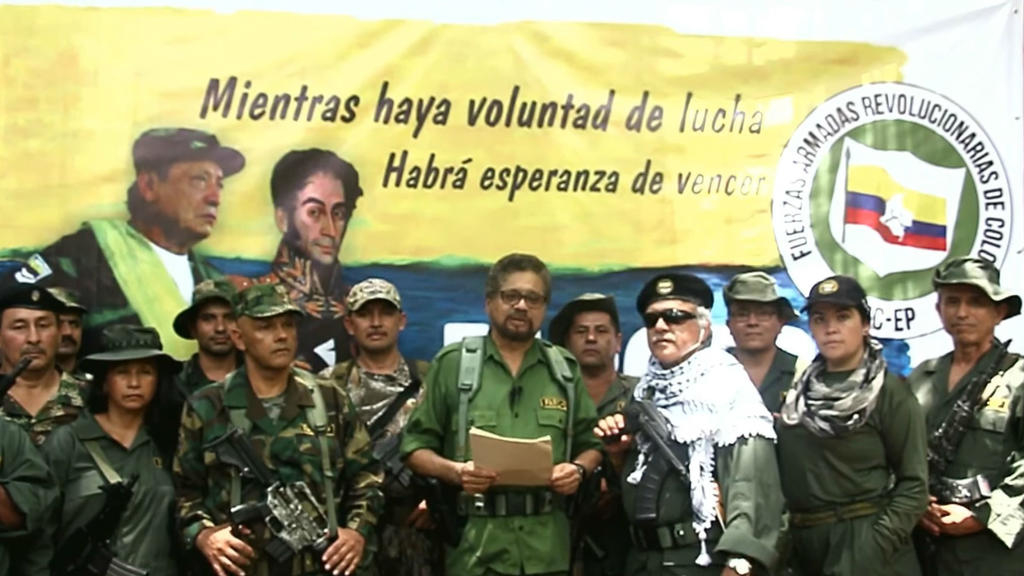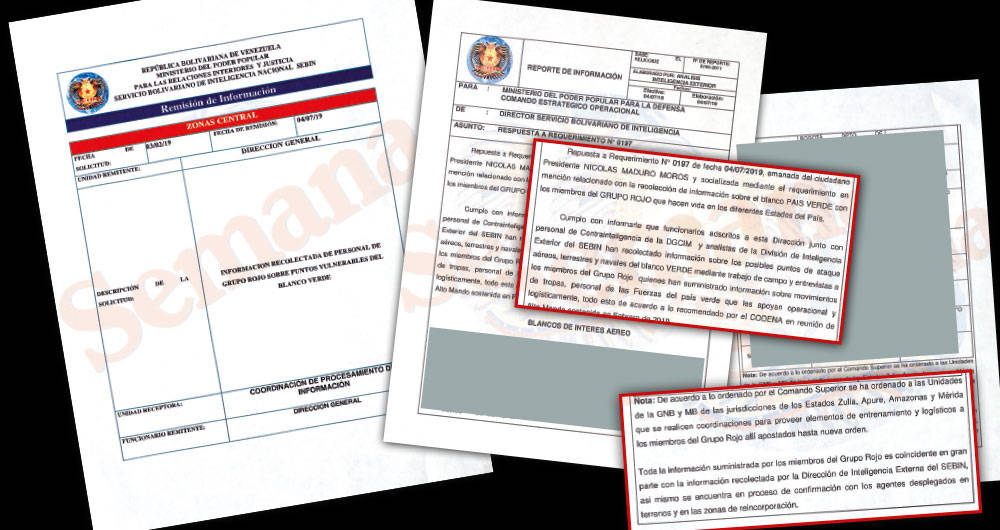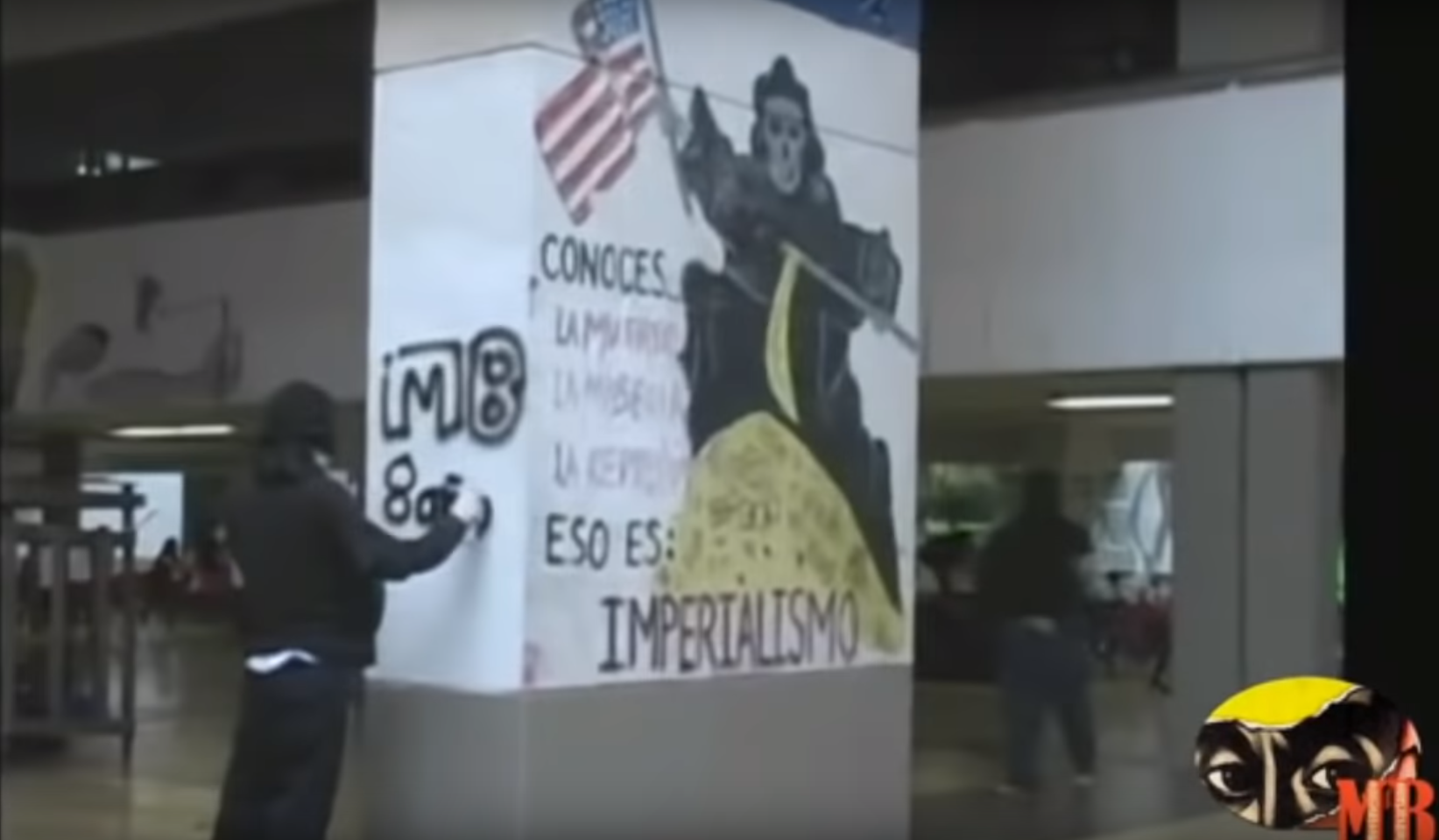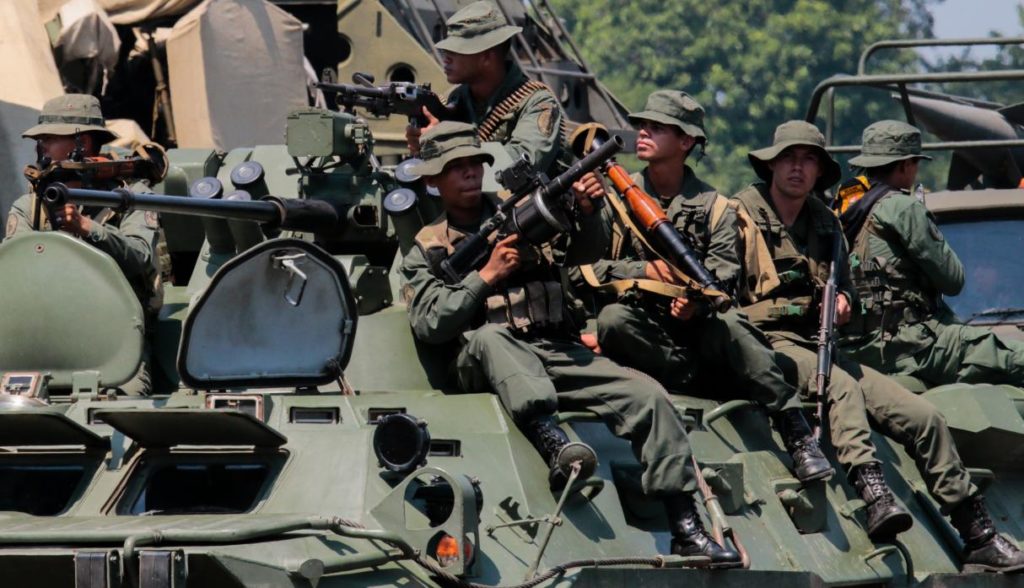With Maduro’s enthusiastic support of Colombia’s FARC and ELN guerrillas, the region is looking an awful lot like the Middle East
We are now either in a state of war and on the verge of a wider regional conflict, with the FARC peace agreement laying in tatters. Or, the Colombian peace movement is so resilient that the three-year-old accord will prevail, no matter what the armed actors do.
Depending on what you’ve been reading lately, you could be forgiven for believing either one of these wildly different scenarios.
One thing is clear: Some of the highest ranking FARC commanders have given up on the peace process and on August 29th announced that they are taking up arms once again, to wage war on the “corrupt, mafia oligarchy”. But what this means, and where we go from here, has had journalists and the pundit class placing heavy doses of faith in the theories and biases that lie just beneath the surface of their words.
The video announcement made by FARC second-in-command Ivan Marquez, and soon thereafter Jesus Santrich, sent journalists into a frenzy, to not only report the news but also to tell us what it all meant.
“We are at war!” or “peace will prevail!” various sides insisted, as they tried to make sense of the still-unfolding events. This frenzy lasted for several days after the FARC dissidents’ announcement. Among the this-means-nothing peacenik crowd, the cognitive dissonance was palpable. On the other extreme – that being the far right, the uribistas of the land have positioned themselves as cheerleaders of a new war with the dissident guerrilla army.

Screenshot of the video released on Aug. 29, in which FARC commander Ivan Marquez, centre, announced that he and a number of dissident guerrillas were abandoning Colombia’s peace process and taking up arms against the state.
Still others think that any new conflict could spill over Colombia’s borders, and trigger some kind of conflict with Venezuela. President Nicolas Maduro badly needs to deflect attention away from his crumbling country, and ratcheting up tensions with his neighbours – particularly by offering shelter and aid to Colombian rebel groups – does exactly that.
Just over a month ago, Maduro said that FARC leaders Santrich and Marquez were “leaders of peace” and that they were “welcome in Venezuela” (his usage of the word “peace” must have been a euphemism for something.) Marquez, Santrich, another senior commander who goes by the alias ‘El Paisa’, and their merry band of guerrillas are likely in Venezuela, something that the administration of Colombian President Ivan Duque has claimed for a long time. Duque plans to present evidence to the United Nations later this month that purports to show that Maduro is “harbouring terrorists”.
In response, the Maduro regime on Tuesday ordered roughly 150,000 Venezuelan troops to begin conducting training exercises along the border with Colombia, with an array of heavy equipment that includes mobile missile launchers.

(Left) Venezuelan leader Nicolas Maduro, along with wife Cilia Flores, and Venezuelan Defense Minister Vladimir Padrino Lopez, seen riding on an armoured vehicle on Sept. 10. (Right) A Venezuelan surface-to-air missile launcher.
The concern is that these tensions lead to border skirmishes or even full-scale fire fights, and wars have been started over less.
“If there are cross-border attacks from Venezuela to Colombia, we can expect Colombians to react,” US special envoy on Venezuela, Elliott Abrams, was quoted by the Washington Post as saying. “And obviously, we would fully support Colombia in that situation.”
Fears about the spectre of war, outlandish as they may seem, are shared by others as well.
“There are several reasons why Venezuela, Colombia, Brazil and, perhaps, even the United States – each for their own reasons – may be, intentionally or not, heading toward a regional conflict,” prominent journalist Andres Oppenheimer said in an op-ed recently.
“If Colombia-Venezuela tensions escalate, Maduro would present his country, and himself, as alleged victims of Colombia-US ‘aggression’. In his mind, that could help him stir nationalist passions at home and improve his dismal popularity ratings,” Oppenheimer stated.
FARC Intelligence for Venezuelan Guns
The heightened tensions and sabre-rattling come at a time when hundreds, maybe thousands of guerrillas, both dissident FARC guerrillas and ELN rebels, are operating within Venezuelan territory. But while most Colombian media state as a fact that the FARC call-to-arms announcement was made inside Venezuela, the group itself claimed to have shot the video in the Inírida River region in Colombia’s Guainia province, not far from the Venezuelan border.
All doubt about whether the rebels were using Venezuela as a base were put to rest on Sunday, when the weekly news magazine Semana published an exposé detailing how the regime’s military has been ordered to give shelter, weapons and training to Colombian guerrillas inside Venezuela, in exchange for intelligence on the location of Colombian military bases and installations.
The report, based on leaked Venezuelan government documents, quotes high-ranking military officers – including Admiral Remigio Ceballos, strategic operational commander of the Venezuelan Armed Forces, directing all Venezuelan generals to establish contact with the guerrillas.
The order comes right from the top: “I respectfully inform you through this communication, by order of President Nicolas Maduro Moros, to avoid confrontation with the red group … to provide logistical support and training centres”, and to “guarantee that food and basic hygiene needs are met”, the document, dated August 9th, reveals.

On Sept. 8, Colombian news magazine Semana published excerpts from a cache of leaked Venezuelan military documents it received from an unidentified source. Venezuelan authorities dismissed the documents as faked.
The “red group” is a codename for either the FARC or ELN guerrillas, while the “training centres” are Colombian rebel camps set up inside Venezuela.
The regime rolled out the red carpet for the “red groups” because of what they were getting in return: “…the SEBIN foreign intelligence division has collected information on the possible air, land and naval attack points of the green target through field work and interviews with the members of the red group, who have provided information on the movements of troops, personnel, and the forces of the green country,” another document stated.
The “green target” or “green country”, in this instance, is the codename for Colombia.
The intelligence that the guerrillas gave to the Venezuelan military went into so much detail that Semana chose to redact large parts of the cache of documents for national security reasons.
The news magazine did not reveal how they obtained the documents.
They nevertheless would help the Venezuelan military to “destroy, capture or neutralize the facilities necessary for the movement of goods, services and information in the civil and military field”, one section of the document states – and which shows a detailed list of infrastructure targets in Colombia.
Despite the Semana report and the Venezuelan military buildup at the border, the Duque administration chose not to send more Colombian troops to patrol the border regions, ostensibly to avoid any new provocations.
“Additional troops will not be sent to the border with Venezuela and much less will increase military activity,” an anonymous government source told El Tiempo newspaper on Tuesday.
“There will be special vigilance over the area, as it is daily in order to maintain sovereignty, take care of border crossings and curb illegal activities such as drug trafficking and smuggling. We will be alert,” the source added.
Venezuela’s Guerilla Proxy War
As the FARC dissidents have pledged to launch an armed offensive against Colombian state forces, Maduro is likely to hedge his bets and aid the guerrillas in their insurgency, rather than risk an all-out war that would doubtlessly lead to the regime’s demise.
But how effective are the FARC as a fighting force, given their new alliances? A look at the numbers is revealing.
More than 13,000 FARC members were said to have demobilized in 2016 as part of the Peace Accord, and just over half of those – around 7,000 – were active guerrilla fighters. Currently, Colombian authorities estimate that FARC commander Ivan Marquez has roughly 2,200 fighters under his command – meaning that one-third of all FARC fighters have abandoned the peace process, in all probability due to a lack of progress, empty promises, and assassinations of dozens of former FARC rebels.
Related: Peace in Colombia? What Peace?
In their return-to-arms announcement two weeks ago, Marquez said he would seek to coordinate the new insurgency against the Colombian government with the ELN guerrillas. On the same day, an ELN commander known as Uriel, the leader of the group’s Chocó front, released a video welcoming his FARC comrades back into the “popular resistance”, and said the ELN was open to an alliance.
Like growing numbers of FARC rebels, the ELN has already firmly established themselves in Venezuela, and is said to be profiting from the “taxing” of illegal mining operations and drug smuggling routes. Colombian analysts estimate that as many as 1,000 ELN rebels – or around 40 percent of the group’s fighting force – operate from Venezuela.
The implication here is that the ELN has a total force of around 2,500 fighters, spanning both sides of the border. If endeavours to coordinate the insurgency with the FARC dissidents prove successful, then Colombia faces a guerrilla army of some 4,700 fighters.

Screengrab taken from a FARC-distributed video of an alleged ‘Bolivarian Movement’ member spray-painting a wall in this undated image.
That number could prove to be even greater. Dissident commander Santrich on Sept. 3rd sent out a call to the so-called “Bolivarian Movement” – a euphemism for urban “clandestine cells” of FARC supporters in major Colombian cities who are willing to aid the guerrillas, and even carry out attacks that “don’t discriminate except against those who are enemies of the people”.
***
Regardless of the numbers, both the FARC and the ELN have proven they have the capacity to strike deep into the heart of power (namely Bogota) when they really want to. In 2003, the FARC blew up the up-scale El Nogal Club in Bogota, killing 36; in January of this year, an ELN suicide bombing at a police academy in the capital killed 21 police cadets.
With the guerrilla groups working as one, armed, funded, trained by the Venezuelan military, and with sleeper-cells ready to be called upon in the major cities, we are witnessing a new phase in Colombia’s decades-long war. A war that was never stopped by the 2016 Peace Accord; indeed the killings increased after the deal. With Maduro’s enthusiastic involvement, the new rogue-state-guerrilla nexus looks an awful lot like the Middle East, where a bellicose Iran uses Hezbollah militants to fight a proxy war with Saudi Arabia in Syria, Yemen, Iraq and elsewhere.
In the Latin American context – if Venezuela is Iran, and the FARC/ELN guerrillas are Hezbollah – what does that make Colombia?

Journalist. Misfit. Malcontent. Provocateur. Is a better Colombia is possible? We’re starting to have doubts.

